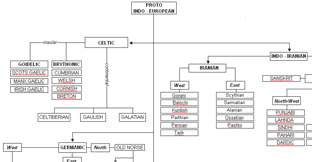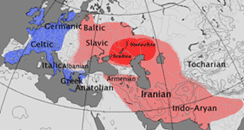1. In the beginnings of the Indo-European or Indo-Germanic studies (already using the comparative grammar), the Indo-European (or IE) language was reconstructed as an unitary language; for Bopp (and the first Indo-European scholars), it was the search of The IE. It appeared, then, at one place (in Europe or Asia) and at one point in time (more or less at some point between ten thousand and two thousand years ago, depending on the individual theories), and spread thereafter in individual languages which in turn had different dialects and so on.
 Sample of a Genealogical Tree of the IE languages [© gfdl]
Sample of a Genealogical Tree of the IE languages [© gfdl]
2. The Stammbaumtheorie, or Genealogical Tree theory, states that languages split up in other languages, each of them in turn split up in others, and so on, like the branches of a tree. For example, a well known old theory about IE is that, from The IE, two main group of dialects known as Centum and Satem (because of their pronunciation of the gutturals, like in the word kmtom, hundred) separated, and from them anothers split up, which would be the common ancestors of the present languages, like Proto-Germanic (or Germanic), Proto-Italic (or Italic), Proto-Celtic (or Celtic), and so on.
 Classic, wrong, satem-centum dialect map [© gfdl]
Classic, wrong, satem-centum dialect map [© gfdl]
NOTE. The division in Centum and Satem is one of the oldest known features of the IE languages, and is still in use by many (usually uninformed) to classify the languages in two groups, thus generally disregarding the huge knowledge acquired in the last hundred years by IE scholars; especially the general agreement in the lack of relevance of phonetic isoglosses as this one for a general classification into main groups of dialects.
3. The Wellentheorie, or Waves Theory, from J. Schmidt, states that one language is created from another by the spreading of innovations, like the waves of the water when a stone hits it: hence the name. The lines which define the extension of the innovations are called isoglosses. The existence of different isoglosses over a common territory signals the existence of a new language or dialect. But there are transition zones, where languages or dialects and isoglosses do not coincide.
4. Every single theory of these old times supposed, then, that the objective was to obtain one IE, The IE, and every discovery of that or this feature of any language was then inserted into the main unitary Scheme, thus classifying them into innovations or archaisms of the old, native Proto-Language.
5. The Europaio is based mainly on The IE. Not because it upholds the traditional views, but because, even though we support the modern Three-Stage theory, we still look for the immediate common ancestor of the European languages, and this is still this old, unitary IE. Indeed, our vision is not that of the traditionalists, nor can our final output be theirs, as the assumption of the new theories imply a different approach to The IE; seen as a whole, though, our system is almost The IE, but for some due changes.
NOTE. In fact, most works on which the Europaio is based, especially those of the vocabulary, are in turn based on these old sources, although they have been revised by new scholars from the point of view of the new theories.